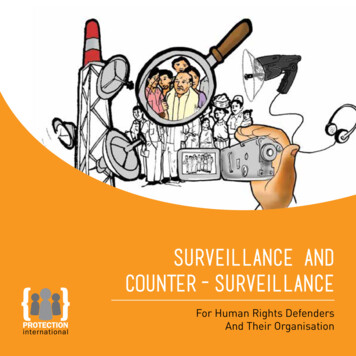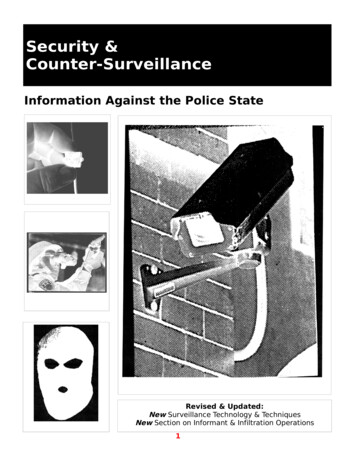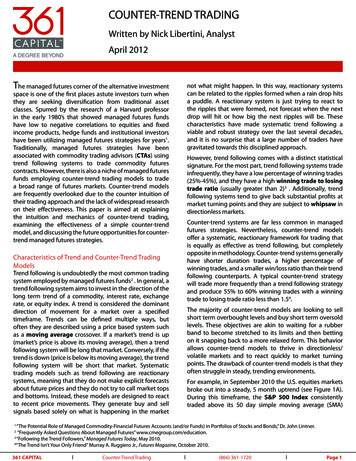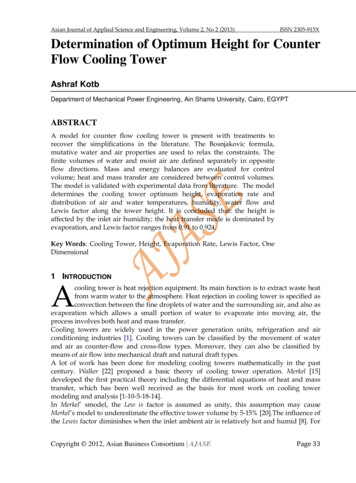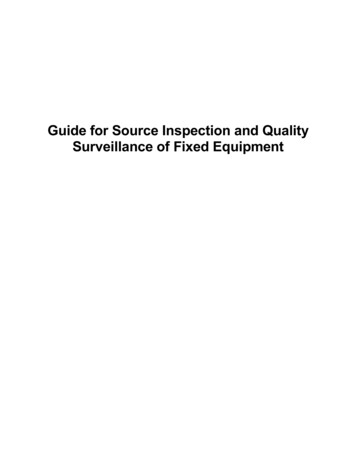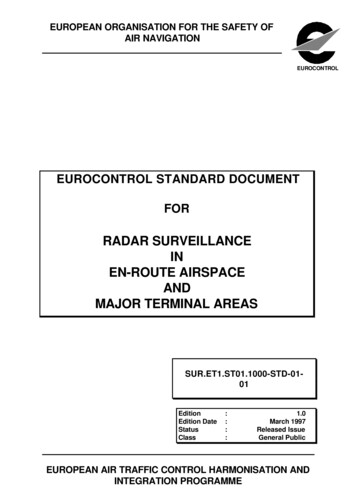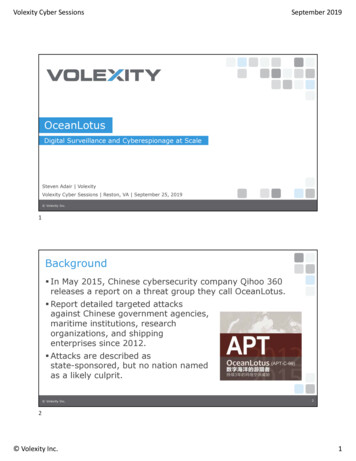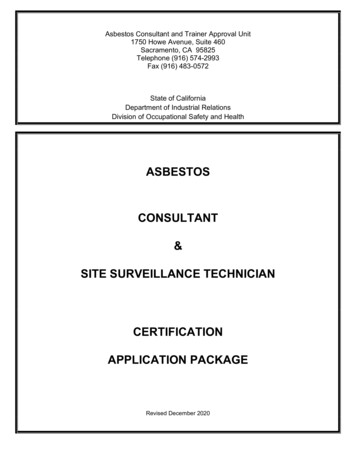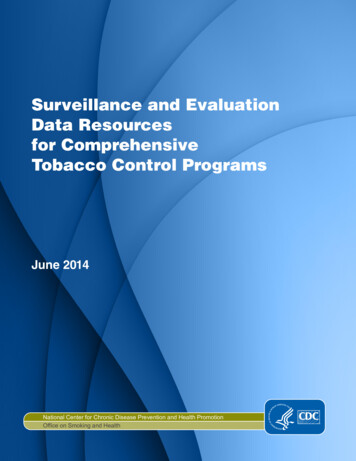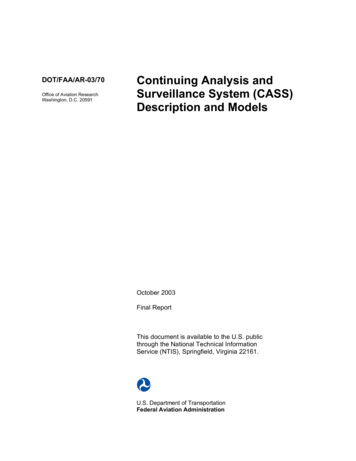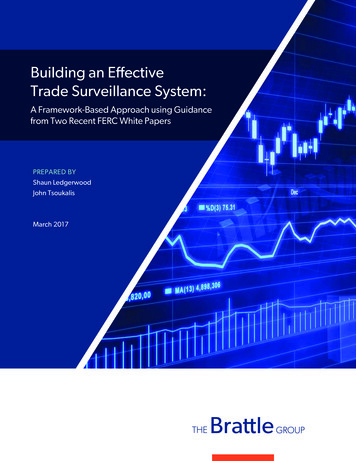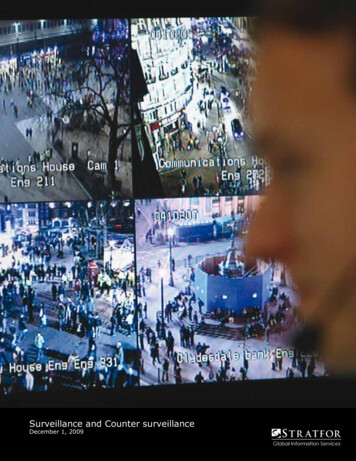
Transcription
Surveillance and Counter surveillanceDecember 1, 2009
STRATFOR Global Information ServicesSTRATFOR Global Information Services publishes intelligence,analysis and research for professionals in government, corporationsand research institutions. For more than a decade, this informationhas helped customers monitor, track and manage political risk andinstability around the world.STRATFOR Global Information Services delivers information in threeways: via password protected websites, customized information anddata feeds and customized briefings and presentations. More than1 million professionals rely upon this information at organizationsthat range from The U.S. Air Force to Yale University to The FederalReserve Bank of Atlanta and others.STRATFOR Global Information Services700 Lavaca Street, Suite 900Austin, TX 78701Tel: 1-512-279-9462www.stratfor.comElectronic deliveryReports are also available online by subscribing at www.stratfor.com.Copyright 2009 STRATFOR. All Rights Reserved. Neither this publication norany part of it may be reproduced, stored in a retrieval system, ortransmitted in any form or by any means, electronic, mechanical,photocopying, recording or otherwise, without prior permission ofSTRATFOR.All information in this report is verified to the best of the author’sand the publisher’s ability. However, STRATFOR does not acceptresponsibility for any loss arising from reliance on it.To learn more please contact Patrick Boykin, Vice President, bycalling 1-512-279-9462.
Surveillance and Counter SurveillanceDecember 1, 20095Surveillance: For Good -- and for Evil7The Spread of Technological Surveillance8Physical Surveillance: Tailing Someone on the Move11Physical Surveillance: The Art of Blending In12Turning the Tables on Surveillantsiii
Surveillance andCountersurveillanceSurveillance:For Good -- and for EvilWhether terrorists are attempting to assassinate a high-ranking governmentofficial, bring down a building or explode a bomb in a subway, their first orderof business is to determine how best to set up the attack. To make such adetermination, pre-operational surveillance of the target is vital.If the target is a person, surveillance will determine his or her patterns ofbehavior; for a building, subway or other facility, the surveillance would helpdefine possible weaknesses. In this way, attackers can determine the best time,location and method for the attack; how best to take advantage of the element ofsurprise — and how to escape afterward.Courtesy of STR/AFP/Getty Images.Passengers watch as a crowded subway train leaves a station in Beijing. These are major targets for terrorist attacks.
Terrorists, of course, are not alone in this regard. Carrying out an attack of anykind — a bank robbery, purse snatching or kidnapping, for example — requiresthat the perpetrators eye their target in advance, although the extent of thesurveillance and its complexity will vary depending on the scale of the operationand the end goal. A purse snatcher, for example, might size up the victim foronly a few seconds, while terrorists could assign a special team for this specificmission and then take up to several weeks to get the job done. Kidnappers andassassins also conduct surveillance of varying lengths to understand the target’sdaily routine, including the time he leaves the house in the morning and theroute he takes to work.U.S. and Jordanian intelligence indicates that the cell involved in the Nov. 9suicide bombings in Amman, Jordan, conducted surveillance on all three hotelsinvolved, though details about the length and degree of surveillance remainmurky. The perpetrators of the April 1992 kidnapping of Exxon executive SidneyReso conducted extensive surveillance and found that Reso was most vulnerablewhen he reached the end of his driveway on the way to work in the morning.Reso died while in captivity.Stalkers or mentally disturbed individuals who fixate on someone surveil theirvictims in advance, although in many cases the stalker wants to get caughtand thus does not need to be looking for possible escape routes. Also, a stalkerusually strikes impulsively with little consideration given to the consequences.Stalkers or lone wolf attackers generally will conduct surveillance alone, makingthem difficult, but not impossible, to spot.A great deal of surveillance also is conducted for purposes of collectinginformation. U.S. government employees and American businesspeople andbusiness facilities overseas are routinely subjected to surveillance by localintelligence agencies in places such as China, France and Israel. The goal hereis economic espionage aimed at keeping abreast of business activities — andstealing business secrets. Industrial spies, though working for themselves orfor private concerns, have similar goals. Private investigators routinely observepeople and places for their clients, usually to link an individual to a particularactivity or event.Not all surveillance is conducted for nefarious purposes, however. On thecontrary, surveillance is an integral part of U.S. law enforcement and intelligenceoperations designed to prevent criminal and terrorist activity. Security personnelplace closed circuit TV in retail stores and banks to deter criminals, while policeofficers stake out certain street corners to keep tabs on drug-traffickers, forinstance.Surveillance is a fact of life in the 21st century. In many ways, technologicaladvances have made it easier for law enforcement to protect citizens. Theseadvances, however, also have made it easier for those who wish to do harm.5
Homeland Security Secretary Janet Napolitano, and key DHS officials, monitor events across the United States.The Spread ofTechnological SurveillanceAs far back as the 5th century B.C., Chinese warrior-philosopher Sun Tzuwent on record citing the paramount importance of using spies and clandestinereconnaissance to uncover enemy plans. At the time — and for centuriesafterward — surveillance involved placing an operative close enough to a targetto track his movements or overhear his conversations. Technological advances— especially those that have come along over the past century — have made itpossible not only to watch and listen to others from afar, but to do so with ease.Today, technical surveillance is conducted for a wide variety of purposes byindividuals as diverse as terrorists, private investigators, activists, paparazzi,peeping toms, law enforcement and governments — and even by parents wholisten in on their infants via baby monitors. These people are tracking a subject’sactivities, usually from a distance or remotely, using devices specifically designed6
or adapted for that purpose such as global positioning system (GPS) locaters,sophisticated listening devices and cameras of all kinds.Al Qaeda used technical surveillance when targeting financial institutionsin Washington, D.C., New York and Newark, N.J., and potential targetsin Singapore in 2003. In New York, for example, several operatives sat in aStarbucks café across the street from their intended target and recorded variousaspects of the institution’s security measures and building access. Their notes andsome of their videos were found on a laptop computer after authorities brokeup the cell. Although al Qaeda’s uses less-sophisticated technology than some— hand-held cameras versus micro-cameras and bionic ears, for example — thenetwork’s ability to conduct technical surveillance still is formidable.Environmental activists, animal rights activists, anarchists and anti-globalizationactivists frequently surveil their subjects before staging a protest or “direct action”operations. Groups that target corporations for sabotage, such as the EarthLiberation Front, are especially sophisticated in the use of technical surveillance.The Ruckus Society is a group devoted to training activists in “electronicscouting” — technical surveillance involving the use of remote cameras, GPSlocators, frequency counters, programmable scanners and night-vision goggles.Program graduates, then, utilize high-tech equipment such as miniature remotecameras and “bionic ear” listening devices to conduct their surveillance. Theseactivists frequently use programmable scanners and cameras to monitor security/police communications and activity in order to warn the saboteurs of animpeding response by law enforcement.In some countries, it is not uncommon for Western business or governmenttravelers to find telltale signs of listening devices in their hotel rooms, offices,meeting rooms and chauffeur-driven cars. In other instances, people have beencaught spying on others in public bathrooms and changing rooms using tinycameras that can be concealed in something as seemingly innocuous as an airfreshener or electrical outlet.The accessibility and miniature size of today’s surveillance equipment makesit easy for just about anyone to clandestinely watch another. As technologycontinues to advance and surveillance becomes even more ubiquitous, methodsto thwart such eavesdropping also will improve.Physical Surveillance:Tailing Someone on the MoveThe image of the darkly clad private eye slipping in and out of doorways as hesurreptitiously tails his subject around the busy city is straight out of the movies.The fact is, however, that physical surveillance often is carried out this way —using a lot of shoe leather. Technological advances and expert training in stealthhave made the job easier than in the past, but when it comes down to it, there isno other way to keep an eye on a subject who is on the move.Technical surveillance is carried out remotely, usually through video or audiorecording equipment, and the subject remains in one place, such as a hotel room,home or office. Physical surveillance, on the other hand, is performed by human7
operatives, and often involves observing the subject’s actions as he travels aroundoutside the home or office.In fact, private investigators lack the enormous human and technical resourcesneeded to get the job done right. This type of surveillance requires a largenumber of highly trained operatives who must be constantly trained asimprovements in techniques are implemented. This requires a significant supportstructure of instructors, facilities, money and material, as well as a well-developednetwork of communications to link the operatives together.Physical surveillance can be broken down into two categories: static and mobile.Static surveillance favors the home team, and puts a visitor or newcomer tothe scene of the surveillance at a disadvantage. If the operatives conductingthe surveillance are familiar with the area, they can better blend in with thelocal scenery, and thus be harder to detect. They also can better anticipatetheir subject’s moves. The Soviets used static surveillance against U.S. Embassypersonnel in Moscow during the Cold War. On the other hand, if the subjectis local and the operatives are from outside the area, the advantage goes to thesubject, who would be in a better position to spot people in his environmentwho do not fit in — especially in small settings.However, static surveillance — when carried out properly — is difficult to detectbecause good surveillance operatives blend in with their surroundings and makethemselves as innocuous as possible. As creatures of habit, most people get usedto their surroundings, and fail to notice things they see every day. By blendingin with the scenery the subject sees every day, such as the local neighborhoodor route taken every morning to work, the operative can effectively becomeinvisible. Because of this, static surveillance requires a high degree of situationalawareness — and a certain amount of paranoia — to detect.Although static surveillance is the hardest type to detect and counter, it isexpensive — as it can involve renting apartments, stores, street vendor kiosksand carts and other similar observation posts, known as “perches” in surveillancejargon. Because the operatives do not move, static surveillance requires thatoperatives be perched at close intervals so that they can keep a constant eyeon the target. In general, only governments have the manpower and resourcesnecessary to do this type of surveillance properly.Mobile surveillance can be carried out in two ways: in vehicles or on foot. Awider area can be covered in vehicular surveillance — and is vital if the subjectis traveling by car — although this type of surveillance does have limitations.Should the subject go into an office building, a subway or a shopping mall, forexample, the operatives in the vehicle cannot follow. Because of this limitation,vehicular surveillance is usually carried out in conjunction with foot surveillance.The operatives on foot are in communication with the operatives in the vehicle.In addition, the operatives in the vehicle will often drop off one of their teamto continue following the target. Mixed car/foot operations are effective becausethe target more often will focus on other pedestrians rather than the cars aroundhim.8
Courtesy ofDANIEL GARCIA/AFP/Getty Images.People crossing San Martin street, at one side of Plaza San Martín in Retiro, one of the historical neighborhoods of Buenos Aires.Depending on the resources available or allocated for a specific operation, mobilesurveillance can range from an operative following the subject on foot — thehardest type of surveillance to accomplish without being detected — to anelaborate operation that puts the subject in a “bubble.” The highest level involvesmultiple mobile and static surveillance teams all linked by communications andcoordinating with one another to ensure that the subject’s every movement ismonitored — and that the team is not detected.The bubble also provides protection against any erratic move the targetmight utilize to determine if he is being watched, or to ditch the surveillance.Therefore, if the team senses that the target has begun to “stairstep” (a series ofde
route he takes to work. U.S. and Jordanian intelligence indicates that the cell involved in the Nov. 9 suicide bombings in Amman, Jordan, conducted surveillance on all three hotels involved, though details about the length and degree of surveillance remain murky. The perpetrators of the April 1992 kidnapping of Exxon executive Sidney Reso conducted extensive surveillance and found that Reso .
